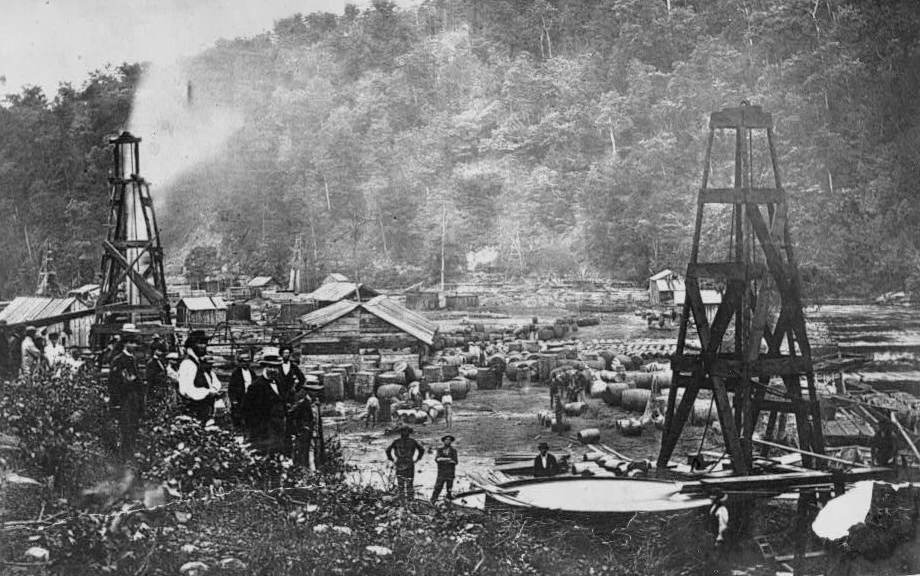Startling Discovery: Great Oil Excitement
Middlebury Register (Vermont), December 28, 1859

To the Editor of the Boston Journal:
The people of Western Pennsylvania, as you already know, have just made the exciting discovery that they are walking over streams or lakes of coal oil, richer in wealth than the best gold mines of California. From intelligent persons on the spot, who are magna pars of the whole matter, and from personal knowledge I have gathered the following reliable facts:
There is subterranean coal oil in Crawford and Venango Counties, Pa., in very large, if not exhaustless quantities. When rectified, it is a pure translucent article, a clear strong burner, wholly un-explosive, does not congeal in the least at 18 or 20 degrees below zero is, of course, the best known oil for lighthouses, ships, etc. And is the most perfect lubricator of machinery, as it does not gum or thicken like other oils. The discovery is confined to the banks of Oil Creek. This is a stream of some size, which issues from a small lake in the northwestern part of Pennsylvania. It runs south-southeast, through parties of Crawford and Venango Counties, and empties into the Allegheny River about 75 miles above Pittsburgh. On this stream, about 14 miles above its junction with the Allegheny, stands the village of Titusville, the chief seat of the oil discoveries and operations.
From the most ancient times it has been well known that there was more or less petroleum oil in the bottom and border lands of this creek. It floats on the surface of the streams, and was collected by the Indians and poor people for lights. In places, it drips out of the rock banks in a very pure state, and hence is called rock oil. Hundreds of large and deep pits were dug in the most ancient times for the oil, which pits are still traceable, though the tree growing on the earth thrown up in the digging are from 200 to 250 years old. The petroleum still oozes largely into pits of any depth, dug in the bottom and border lands of the creek.
The discovery came in this way. The lands on Oil Creek are chiefly owned by a company who manufactures lumber at Titusville. One of the partners gave some attention to the oil matter. A company was formed in New York called “The Pennsylvania Rock Oil Company.” They bought a piece of land near Titusville to work for oil. Some of the pit petroleum was analyzed by Prof. Silliman of Yale College, who found in it 80% of a pure coal oil. This company went through changes. Nothing was done to work for oil, and finally most of the stock fell into the hands of a man residing in New Haven, Connecticut.
In 1858, a Mr. Drake took a lease of the New Haven Company for working their oil lands at Titusville, as he pleased, and at his own expense, for fifteen years, only giving to them twelve and a half cents for every gallon of oil obtained.

Under this lease, in May last, Mr. Drake commenced sinking an artesian well for salt, oil or anything which might turn up. Boring through forty-seven feet of gravel and twenty-two of shale rock, with occasional small apertures in it, he struck, in August, a large opening, not yet explored as to depth, or area, but filled with coal oil, somewhat mixed with both water and gas. A small pump on hand brought up from 400 to 500 gallons of oil a day; an explosion soon blew it up. One of three times its size and power was put in its place, and during the first four days threw up 5,000 gallons of oil; 1,250 gallons per day, or one gallon per minute for twenty hours, fifty minutes, each day. The oil as raised was worth 80 cents a gallon, which produced the large income of $1,000 per day for four successive days. So, the matter goes on yielding about one gallon per minute during working time.
Of course, there was no small stir. A hundred strangers daily arrived at Titusville to see, to wonder, to buy oil lands. Half, third, quarter rights in land, enough to sink an artesian well, with real estate generally, rose to very high figures. Many poor people, owning a little land, became suddenly rich. The New Haven swamp lands, formerly regarded worthless sold for taxes, then for a cow, were not marked $100,000 per acre.
The oil in Mr. Drake’s well, is undiminished by any amount of pumping, Capitalists are on the alert. Ten companies are already boring; twenty-five more are making haste to begin. A large company called the “Consolidated Rock Oil Company,” with a capital of $1,000,000, has been formed in New York to buy and work the oil lands.
This matter presents some deep questions for the historian, the geologist, and the merchant:
- What race of men dug those oil pits more than 200 to 250 years ago?
- Where are the immense Coal Beds from which this oil flows? Are they above or below the level of the oil.
- What effect is all this to have on the whaling interest, and on all those branches of industry which now supply the burning and lubricating oils?
New and interesting things will doubtless occur in the progress of this matter, of which, with your consent, Mr. Editor, I will try and keep your readers informed.
– H. R.
